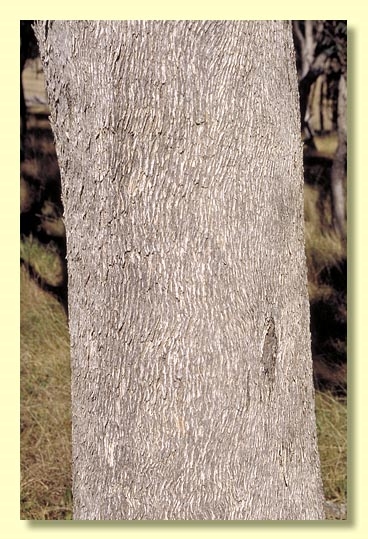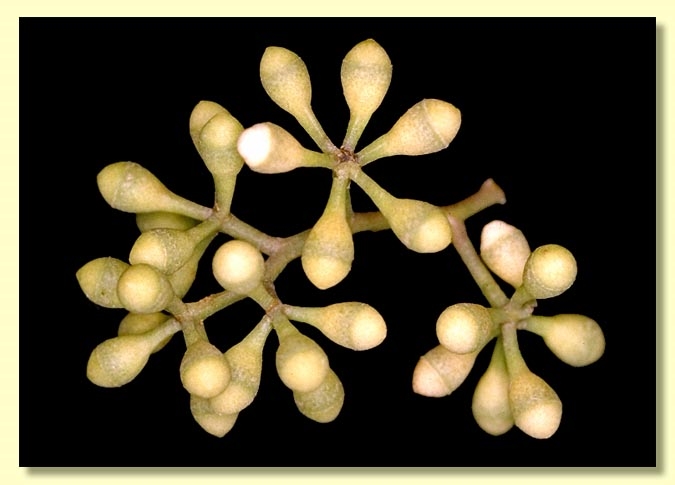Euclid - Online edition
Eucalyptus conica
Eucalyptus | Symphyomyrtus | Adnataria | Terminales | Heterophloiae
E. baueriana var. conica (H.Deane & Maiden) Maiden, Proc. Linn. Soc. New South Wales 27: 216, 217 (1902).
T: New South Wales. 2 miles NE of Cowra, R.H. Cambage s.n., 24 July 1899; lecto NSW [NSW 320940]; fide Bean, A.R., Telopea 12(3): 310 (2009).
Bark rough on trunk and branches to about 8 cm diameter, box-type, often tessellated or flaky, grey or grey-brown, smooth bark whitish.
Juvenile growth (coppice or field seedlings to 50 cm): stem rounded in cross-section; juvenile leaves always petiolate, opposite up to node 5 or 6 then alternate, ovate, 4–8 cm long, 1.4–4.5 cm wide, green to blue-green.
Adult leaves alternate, petiole 0.8–2.3 cm long; blade narrowly lanceolate to lanceolate, 5.5–14 cm long, 1–2.5 cm wide, base tapering to petiole, concolorous, dull, green to blue-green, side-veins usually greater than 45° to midrib, densely to very densely reticulate, intramarginal vein parallel to and remote from margin, oil glands island and intersectional.
Inflorescence terminal compound but some axillary unbranched also, peduncles 0.3–1.5 cm long, buds 7 per umbel, pedicels 0.2–0.6 cm long. Mature buds obovoid to diamond-shaped, 0.4–0.5 cm long, 0.2–0.3 cm wide, green, scar present (outer operculum shed early), inner operculum conical, rounded or beaked, stamens inflexed, with outer staminodes, anthers adnate, positioned obliquely at filament tip, cuboid to cuneate, dehiscing by terminal pores, style long, stigma tapered usually blunt, locules 3 or 4, the placentae each with 4 vertical ovule rows. Flowers white.
Fruit sessile or pedicellate (pedicels 0–0.4 cm long), obconical, 0.3–0.6 cm long, 0.3–0.5 cm wide, disc descending, valves 3 or 4, near rim level or enclosed.
Seeds brown, 0.8–1.3 mm long, flattened-ovoid, often pointed at one end, dorsal surface shallowly pitted, hilum ventral.
Cultivated seedlings (measured at ca node 10): cotyledons reniform; stems rounded in cross-section; leaves petiolate, opposite for 4 or 5 pairs then alternate, ovate-lanceolate, 4–8 cm long, 1.3–3.6 cm wide, base tapering, margin entire, green.
Flowering has been recorded in July, August, September, October, November and December.
A small to medium-sized woodland box tree of the western slopes and adjacent plains north from the Weddin Mountains near Grenfell to the Northern Tablelands (Wollomombi to Jeogla, Enmore, Toryburn, Bolivia, Tingha) of New South Wales, extending into Queensland as far as Mt Moffat, always on loamy flats or heavy alluvial soils on level to gently sloping sites. It has box-type bark to the branchlets, dull green to blue-green crown, buds in terminal inflorescences, and obconical fruit.
Other box species that occur within or near its natural range are the glossy-leaved E. microcarpa and E. pilligaensis and the dull-leaved E. albens, but all three differ from E. conica in holding the outer operculum until flowering and having all stamens fertile (outer stamens sterile in E. conica). E. magnificata occurs to the east of the distribution of E. conica and differs in its larger, slightly glossy adult leaves, orbicular juvenile leaves and often glaucous buds. Yellow box, E. melliodora, also has an overlapping distribution with E. conica, but differs in having axillary inflorescences and small hemispherical to truncate-globose fruit and flaky thin rough bark.
Eucalyptus conica belongs in Eucalyptus subgenus Symphyomyrtus section Adnataria because the buds have two opercula, ovules are in four rows, seeds are flattened-ovoid, cotyledons are reniform, and anthers are rigid on the staminal filaments. Within section Adnataria, E. conica is part of series Heterophloiae having box bark, terminal inflorescences, buds that shed the outer operculum early, stamens inflexed and the outer stamens sterile (staminodes). Other species in this series are E. rudderi from the Taree area of the North Coast of New South Wales, E. baueriana and E. polyanthemos in southern New South Wales and eastern Victoria, E. hypostomatica north from western Sydney to Wattagan State Forest, E. magnificata from the northern tablelands of New South Wales and E. fasciculosa from far western Victoria and adjacent parts of South Australia. An eighth species in the series, E. lucens, is found only west and south-west of Alice Springs in Central Australia.














